Cantalope, Casaba Melon, Casaba Melons, Honeydew Melon, Honeydew Melons, Melon, Muskmelon, Musk Melon, Muskmelons, Musk Melons, Rockmelon, Rockmelons, Spanspek, Spanspeks, Sweet Melon, Sweet Melons, True Cantaloupe, True Cantaloupes
A cantaloupe is a type of fruit belonging to the Cucurbitaceae family, which also includes squash, cucumber, and pumpkin. Cantaloupe is also known as muskmelon or rockmelon, and its scientific name is Cucumis melo. The fruit is characterized by its round to oblong shape, rough netted skin, and sweet, juicy, orange flesh with a musky aroma.
Types: There are two main types of cantaloupes, categorized based on their origin:
European Cantaloupes (Cucumis melo var. cantalupensis): These cantaloupes are characterized by their lightly ribbed, warty, or scaly rind with no netting. The flesh is typically light orange, although the color can vary slightly depending on the specific variety and ripeness of the fruit. The texture is tender and juicy, offering a pleasant mouthfeel when eaten. The flavor is often described as a combination of honeydew melon, peach, and pear, but it can vary slightly depending on factors like the growing conditions, ripeness, and variety.
North American Cantaloupes (Cucumis melo var. reticulatus): Also known as netted melons or muskmelons, these cantaloupes have a distinctive net-like pattern on the rind. The rind is usually tan or light brown, and the flesh is orange with a sweet, musky flavor. North American cantaloupes are more commonly found in the United States and Canada. Popular varieties include Hale’s Best Jumbo, Hearts of Gold, and Ambrosia.
Growth habit: Cantaloupes are annual vining plants that grow on the ground or can be trained to grow on trellises. They require a long, warm growing season, typically between 70-100 days to mature.
Size: Cantaloupe plants can spread to cover an area of 6-10 feet (1.8-3 meters), and the fruits can vary in size, usually ranging between 3-5 pounds.
Flowers: Cantaloupes produce yellow, unisexual flowers (male and female on the same plant). Male flowers appear first, followed by female flowers, which can be identified by a small immature fruit at the base.
Blooming season: Cantaloupes typically bloom in summer, depending on the climate and planting time.
Hardiness: Cantaloupes are not frost-hardy and require warm temperatures, with an ideal range between 70-90°F (21-32°C) for growth.
Uses: Cantaloupes are primarily consumed as fresh fruits, but they can also be used in smoothies, fruit salads, desserts, and as a flavoring for various dishes.
Pollinators: Cantaloupe flowers require pollination by bees or other pollinators to produce fruit, as they do not self-pollinate.
Benefits: Cantaloupes are a rich source of vitamins A and C, beta-carotene, potassium, and fiber. They have antioxidant, anti-inflammatory, and immune-boosting properties.
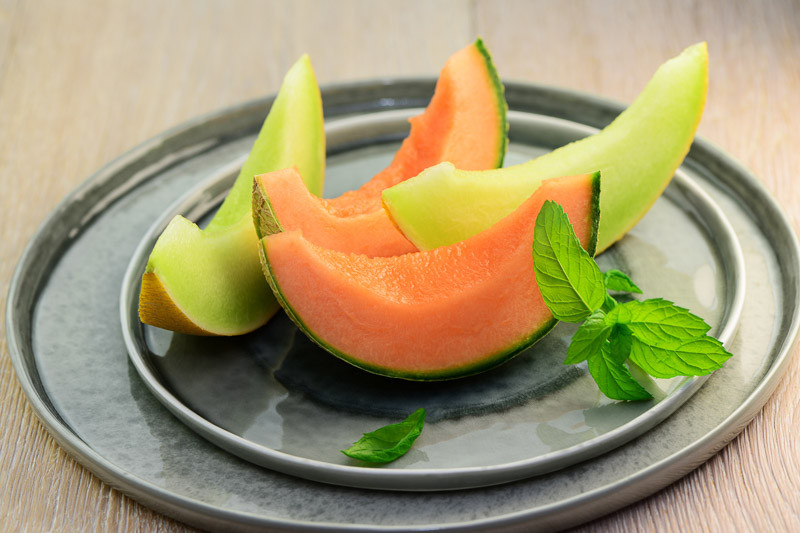
Honeydew and Cantaloupe
Both honeydew and cantaloupe are popular types of melons, each with its own unique flavor and texture. When deciding between the two, consider the following:
Taste: Honeydew melons have a mild, sweet flavor with a hint of tartness. Cantaloupe, on the other hand, has a sweet and slightly musky flavor. Your preference may depend on whether you prefer a milder or more distinct taste.
Texture: Honeydew has a smooth, almost creamy texture, while cantaloupe is firmer and slightly granular.
Color: Honeydew has a pale green flesh, while cantaloupe has a vibrant orange flesh. The difference in color may impact your visual enjoyment of the fruit.
Nutritional content: Both fruits are good sources of vitamins and minerals. Cantaloupe is particularly high in vitamin A, vitamin C, and beta-carotene, while honeydew is higher in vitamin B6 and potassium. Both melons are low in calories and high in water content, making them a hydrating and healthy snack option.
Availability: Both honeydew and cantaloupe are typically in season during the summer months, though availability may vary depending on your location.
Ultimately, the choice between honeydew and cantaloupe comes down to personal preference. Some people may prefer the mild sweetness of honeydew, while others may enjoy the more robust flavor of cantaloupe. You can also combine both in fruit salads or smoothies to enjoy the best of both worlds.
Cantaloupe, also known as muskmelon, is a type of melon with a net-like skin and sweet, juicy, orange flesh. It is a nutrient-rich fruit that offers various health benefits. The following nutrition facts are based on a 100-gram (3.5-ounce) serving of cantaloupe:
Please note that the percentages of daily value (DV) are based on a 2,000-calorie diet. Your daily values may be higher or lower depending on your calorie needs.
Cantaloupe is a nutrient-dense fruit with several health benefits. Some of its key health benefits include:
Rich in antioxidants: Cantaloupe is an excellent source of antioxidants like vitamin A (in the form of beta-carotene) and vitamin C. These antioxidants protect the body from free radicals, which can damage cells and contribute to chronic diseases like cancer and heart disease.
Supports a healthy immune system: Vitamin C in cantaloupe plays a vital role in maintaining a healthy immune system by supporting the production of white blood cells and acting as an antioxidant to protect immune cells from damage.
Promotes healthy skin and eyes: The high levels of beta-carotene (vitamin A) in cantaloupe help maintain healthy skin and good vision. Beta-carotene is essential for the production of pigment in the retina and may help protect against age-related macular degeneration.
Aids digestion: The dietary fiber in cantaloupe can help improve digestion and prevent constipation by adding bulk to stools and promoting regular bowel movements.
Supports heart health: Cantaloupe contains potassium, which is essential for maintaining proper fluid balance, blood pressure, and muscle function. Adequate potassium intake has been associated with a reduced risk of stroke and high blood pressure.
May help with weight management: Cantaloupe is low in calories and high in water content, making it a satisfying and hydrating snack. The fiber content also promotes a feeling of fullness, which can help with weight management.
Supports bone health: Although cantaloupe is not a significant source of calcium, it does contain small amounts of vitamin K and magnesium, which are important for maintaining healthy bones and preventing conditions like osteoporosis.
Remember that maintaining a balanced diet and incorporating a variety of fruits and vegetables is essential for overall health. While cantaloupe provides numerous health benefits, it’s important to consume it as part of a well-rounded diet.
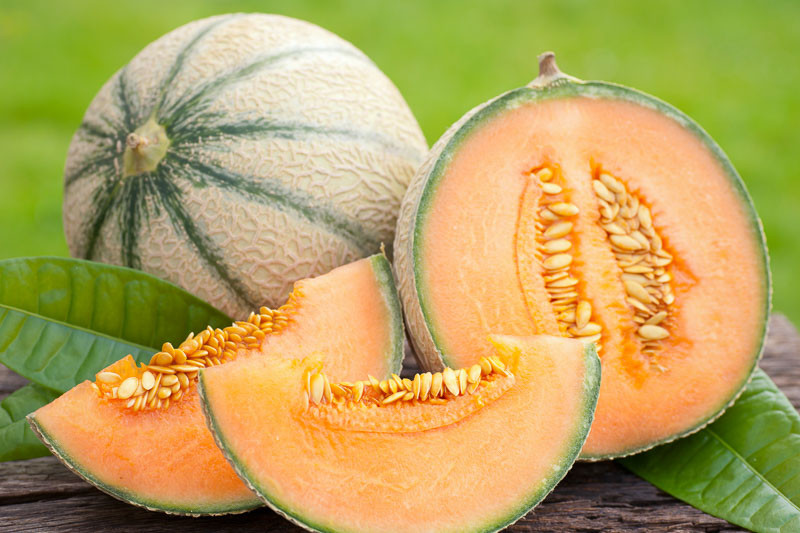
European Cantaloupe (Cucumis melo var. cantalupensis)
Selecting a ripe cantaloupe ensures that you enjoy the fruit at its peak flavor and sweetness. Here are some tips to help you determine if a cantaloupe is ripe:
Color: Look for a cantaloupe with a uniform, creamy, beige or golden color. The greenish tint indicates that the fruit is not yet ripe. The net-like pattern on the rind should be well-defined and stand out against the background color.
Texture: A ripe cantaloupe should have a slightly firm, but not hard, feel when you press the surface gently with your fingers. The rind should have a slight give but not feel mushy. Avoid fruits with soft spots, as they may be overripe or damaged.
Stem end: Examine the stem end of the cantaloupe (the part where it was attached to the vine). It should have a smooth, round indentation, indicating that the fruit detached easily from the vine when ripe. If the stem is still attached or the area looks torn, the fruit may have been picked too early.
Blossom end: Press gently on the blossom end (the opposite end of the stem). A ripe cantaloupe will have a slight give in this area.
Aroma: A ripe cantaloupe should have a sweet, pleasant, and slightly musky aroma. If the fruit has no smell, it may not be ripe yet. A strong, overly sweet, or fermented smell may indicate overripeness.
Weight: A ripe cantaloupe should feel heavy for its size, which suggests that it has a high water content and is full of juicy, flavorful flesh.
Please note that these tips apply mainly to the common netted cantaloupe (also known as muskmelon). Other varieties, like the smooth-skinned Charentais melon, may have slightly different indicators of ripeness. Once you’ve selected a ripe cantaloupe, it can be stored at room temperature for a few days. After cutting, store the fruit in an airtight container in the refrigerator to preserve freshness.
Cutting a cantaloupe is a simple process if you follow these steps:
Wash the cantaloupe: Before cutting, thoroughly rinse the cantaloupe under running water to remove any dirt or bacteria on the surface. You can use a clean produce brush to gently scrub the rind.
Prepare a cutting board and knife: Choose a cutting board with a groove to catch the juices and a sharp knife, such as a chef’s knife or a serrated knife.
Slice off the ends: Place the cantaloupe on the cutting board and carefully slice off both the stem end and the blossom end to create a flat, stable base.
Cut the cantaloupe in half: Stand the cantaloupe upright on one of the flat ends, and then slice it in half vertically from top to bottom. You should now have two equal halves.
Remove the seeds: Use a spoon to scoop out the seeds and any fibrous material from the center of each cantaloupe half. Discard the seeds or save them for another purpose, such as roasting.
Slice into wedges or cut into chunks: There are two common ways to cut the cantaloupe further:
Serve or store: Cantaloupe can be served immediately or stored in an airtight container in the refrigerator for up to 3-5 days. Chilling the fruit can enhance its flavor and texture.
Remember to always use caution when using sharp knives and cutting through the tough rind of a cantaloupe.
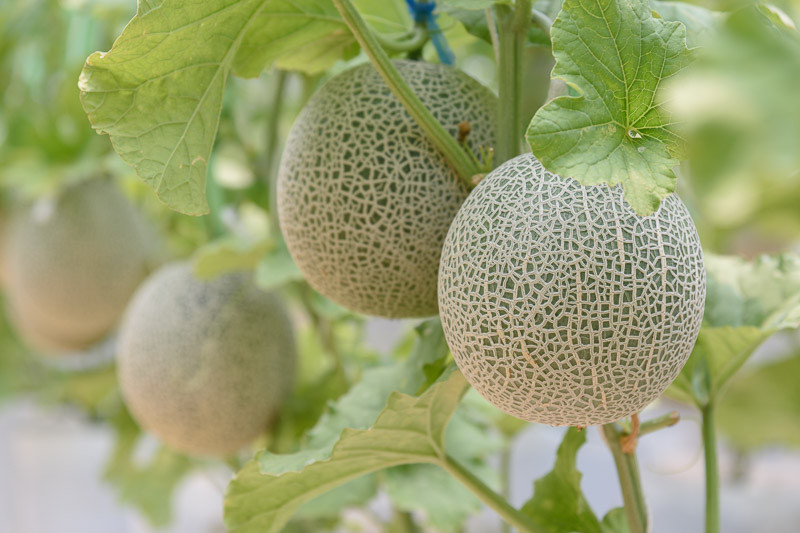
North American Cantaloupe (Cucumis melo var. reticulatus)
Cantaloupe can be enjoyed in various ways, both as a standalone fruit or incorporated into different dishes. Here are some ideas on how to eat cantaloupe:
Fresh: Simply enjoy fresh cantaloupe wedges or chunks on their own as a healthy snack or dessert.
Fruit salad: Combine cantaloupe with other fruits like watermelon, honeydew, pineapple, strawberries, and grapes to create a colorful and refreshing fruit salad.
Smoothies: Blend cantaloupe with other fruits, yogurt, milk, or a non-dairy milk alternative to create a delicious smoothie.
Parfait: Layer cantaloupe chunks with yogurt and granola for a nutritious breakfast or snack.
Salsas: Dice cantaloupe and mix it with other ingredients like red onion, jalapeño, cilantro, lime juice, and a pinch of salt to make a sweet and spicy salsa. Serve it with tortilla chips or as a topping for grilled fish or chicken.
Cold soups: Blend cantaloupe with yogurt, honey, and a splash of orange juice to create a chilled soup. Garnish with mint leaves or a dollop of sour cream.
Prosciutto-wrapped cantaloupe: Wrap thin slices of prosciutto around cantaloupe wedges for a sweet and savory appetizer or snack.
Salad toppings: Add cantaloupe chunks to green salads, along with nuts, cheese, and a light vinaigrette for a unique and refreshing twist.
Grilled: Lightly brush cantaloupe wedges with a little oil and grill them on medium heat for a few minutes per side until they develop grill marks and become slightly caramelized. This method intensifies the fruit’s natural sweetness and adds a smoky flavor.
Frozen treats: Puree cantaloupe and freeze it in popsicle molds to make a refreshing frozen treat. You can also blend cantaloupe with other fruits, sweeteners, or yogurt before freezing.
Remember, cantaloupe can be enjoyed in various forms, so don’t hesitate to experiment with different recipes and combinations to find your favorite way to eat this versatile fruit.
Growing your own cantaloupe plant can be a rewarding experience, offering various benefits:
Freshness and taste: Homegrown cantaloupes often taste better than store-bought ones because they can be harvested at peak ripeness. This allows the fruit to develop its full flavor and sweetness, resulting in a superior taste compared to store-bought cantaloupes, which are often picked before they are fully ripe to accommodate shipping and storage.
Chemical-free produce: When you grow your own cantaloupe, you can control the growing conditions and avoid using harmful pesticides or chemicals. This ensures that your fruit is healthier and safer to eat.
Cost savings: Growing cantaloupe in your garden can be more cost-effective than purchasing it from a store, especially if you regularly consume this fruit. Over time, you can save money by producing your own cantaloupes.
Gardening benefits: Gardening is a fulfilling hobby that can provide physical activity, reduce stress, and improve mental health. Growing cantaloupe can be a fun and engaging project that adds variety to your garden.
Educational opportunity: Growing cantaloupe plants can be an educational experience for children, teaching them about the life cycle of plants and the importance of healthy eating habits. It can also foster a sense of responsibility and appreciation for nature.
Environmental benefits: By growing your own cantaloupe, you reduce the need for transportation, which can contribute to greenhouse gas emissions. Additionally, home gardens can promote local biodiversity and support pollinators like bees and butterflies.
Variety: There are many different cantaloupe varieties available for cultivation, some of which might not be readily available at your local grocery store. By growing your own, you can experiment with unique varieties and discover new flavors.
Before growing cantaloupe in your garden, ensure that you have the appropriate space, climate, and resources to support the plants. Cantaloupe plants need warm temperatures, full sun, and well-draining soil to thrive. They also require a fair amount of space, as their vines can spread out several feet.
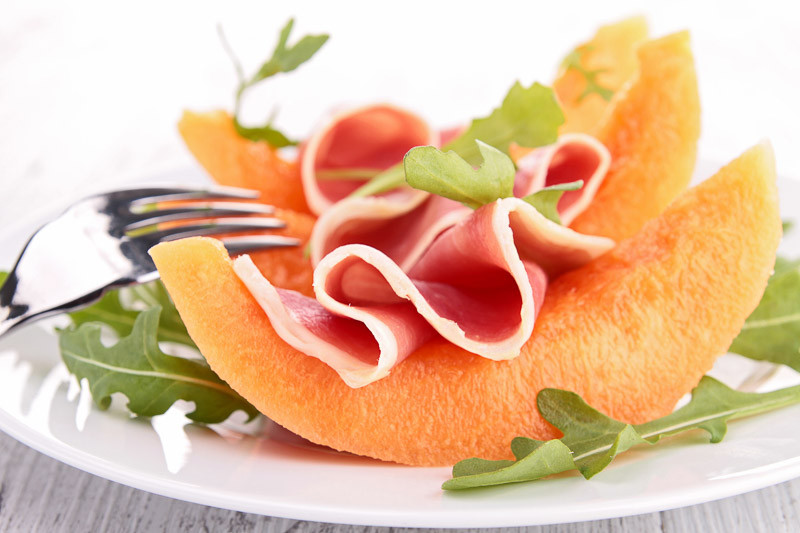
Growing and caring for cantaloupe plants can be a rewarding experience. By following these steps, you can cultivate a successful crop of delicious and nutritious cantaloupes:
Choose the right variety: Before planting, select a cantaloupe variety that is well-suited to your local climate and growing conditions. Consider factors like disease resistance, fruit size, and days to maturity.
Prepare the soil: Cantaloupes grow best in well-draining, fertile soil with a pH between 6.0 and 6.5. Work compost or well-rotted manure into the soil to improve fertility and drainage. If you have heavy clay soil, consider using raised beds.
Plant at the right time: Plant cantaloupe seeds directly in the ground or start them indoors about 4-6 weeks before the last expected frost date. Cantaloupes require warm soil temperatures (at least 65°F/18°C) for germination and growth.
Sow seeds or transplant seedlings: Sow seeds about 1 inch (2.5 cm) deep and space them 18 inches (45 cm) apart in rows that are around 3 feet (90 cm) apart. If you started seeds indoors, transplant the seedlings after the danger of frost has passed and when they have 2-3 true leaves.
Water consistently: Water cantaloupe plants regularly, providing 2 inches (5 cm) of water per week. Keep the soil evenly moist, but avoid over-watering, which can lead to disease and poor fruit development. Drip irrigation or soaker hoses are ideal watering methods.
Fertilize: Apply a balanced, all-purpose fertilizer when the vines begin to run if your soil is lacking nutrients (perform a soil test). Avoid excessive nitrogen, as this can lead to lush foliage growth at the expense of fruit production.
Control weeds: Keep the area around cantaloupe plants weed-free to reduce competition for nutrients and water. Use mulch, such as straw or black plastic, to suppress weed growth and conserve soil moisture.
Provide support: Use a trellis or other support system to keep cantaloupe vines off the ground, which can help prevent pests and diseases. If you’re growing cantaloupes on a trellis, you may need to use a sling or netting to support the developing fruit.
Cantaloupe plants, like other members of the Cucurbit family, rely on pollination to produce fruit. Cantaloupe flowers are either male or female, and both types of flowers grow on the same plant. Pollination occurs when pollen from the male flower is transferred to the female flower, typically by bees or other pollinators. Here are some tips to ensure successful cantaloupe pollination:
Encourage pollinators: Attract bees and other pollinators to your garden by planting a variety of flowers that bloom throughout the growing season. Providing a water source and shelter for pollinators can also help.
Avoid pesticides: Limit the use of pesticides, especially during the flowering period, as they can harm pollinators. If you must use pesticides, choose ones that are specifically labeled as safe for bees and apply them in the late afternoon or evening when pollinators are less active.
Hand-pollination: If pollinators are scarce or you’re growing cantaloupes in a greenhouse, you may need to hand-pollinate the flowers. To do this, follow these steps:
Monitor fruit set: After successful pollination, the female flower will begin to develop into a fruit. Keep an eye on the fruit growth and provide the necessary care and support for the plant.
Remember that proper pollination is crucial for fruit production in cantaloupe plants. By providing a pollinator-friendly environment and using hand-pollination techniques when necessary, you can increase the chances of a bountiful cantaloupe harvest.
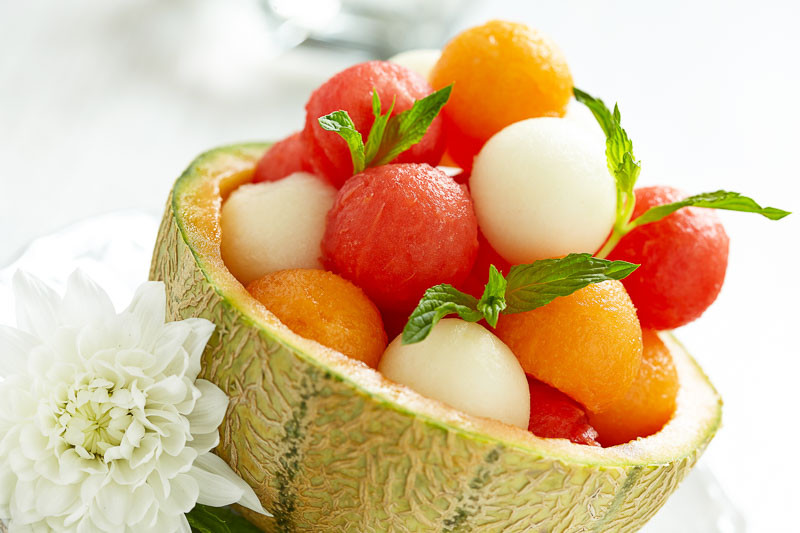
Pruning cantaloupe plants can help optimize fruit production, improve air circulation, and prevent diseases. To prune cantaloupe plants effectively, follow these steps:
Cantaloupes are typically ready to harvest 75-100 days after planting, depending on the variety. Harvesting cantaloupe at the right time is crucial for the best flavor and texture. Here are some signs and tips to help you know when your cantaloupe is ready to harvest:
To harvest cantaloupe:
Remember that each cantaloupe plant may produce several melons, and they may ripen at different times. Regularly monitor your cantaloupe plants and harvest the melons as they become ready to ensure the best taste and quality.
Cantaloupe is usually propagated through seeds rather than vegetative methods. To propagate cantaloupe from seeds, follow these steps:
Obtain seeds: You can either purchase seeds from a reputable supplier or save seeds from a ripe cantaloupe fruit. If saving seeds from a fruit, choose a healthy, ripe melon from a disease-free plant. Note that seeds from hybrid varieties may not produce plants true to the parent type.
Clean and dry seeds (if saving from fruit): Scoop out the seeds from the fruit, rinse them in a strainer to remove any remaining pulp, and spread them out on a paper towel or clean cloth to air-dry for a few days. Once dry, store the seeds in a cool, dry place until planting time.
Start seeds indoors (optional): You can start cantaloupe seeds indoors about 4-6 weeks before the last expected frost date. Plant seeds 1 inch (2.5 cm) deep in seed-starting mix in pots or seedling trays. Maintain a consistent temperature of 70-85°F (21-29°C) for germination, which usually occurs within 5-10 days. Provide adequate light, either from a sunny windowsill or grow lights.
Harden off seedlings: Gradually acclimate indoor-grown seedlings to outdoor conditions by exposing them to direct sunlight and cooler temperatures for a few hours a day over a week before transplanting them into the garden.
Prepare the planting area: Choose a sunny location with well-draining, fertile soil. Work in compost or well-rotted manure to improve soil fertility and drainage. Consider using raised beds if you have heavy clay soil.
Transplant or direct sow: After the danger of frost has passed and soil temperatures are at least 65°F (18°C), transplant seedlings 18 inches (45 cm) apart in rows that are around 3 feet (90 cm) apart.
Water and care for plants: Water consistently, fertilize as needed, and control weeds to encourage healthy growth and fruit production. Monitor for pests and diseases, and implement appropriate management practices.
Cantaloupe plants do not propagate well through cuttings or other vegetative means, as they are annual plants with a single growing season. Therefore, seed propagation is the most effective and practical method for growing cantaloupe.
Cantaloupe plants can be affected by various pests and diseases. Here are some common issues to watch for and general tips on managing them:
Aphids: These tiny, sap-sucking insects can cause stunted growth and transmit viruses. Manage aphids by spraying plants with a strong stream of water or using insecticidal soap or neem oil.
Cucumber beetles: Both striped and spotted cucumber beetles can damage cantaloupe plants by feeding on leaves and fruits and spreading bacterial wilt. Use floating row covers to protect young plants, set up yellow sticky traps, and handpick beetles if the infestation is small.
Squash bugs: These pests can damage plants by sucking sap from leaves and stems. Handpick them or use a vacuum to remove them from plants. You can also use floating row covers to protect young plants and encourage natural predators like ladybugs and lacewings.
Spider mites: Spider mites can cause yellowing and curling of leaves. Control them by spraying with a strong stream of water, using insecticidal soap, or releasing predatory mites.
Slugs and Snails: These pests can damage leaves and fruits. Handpick them at night or use bait traps, diatomaceous earth, or copper barriers to control their populations.
Powdery mildew: This fungal disease appears as a white, powdery coating on leaves, which can cause them to turn yellow and die. Improve air circulation, avoid overhead watering, and apply a fungicide or sulfur to manage powdery mildew.
Downy mildew: This fungus causes yellow spots on the upper surface of leaves and a fuzzy, grayish-white growth on the lower surface. Prevent downy mildew by providing good air circulation, using drip irrigation or watering at the base of the plant, and applying a fungicide labeled for downy mildew control.
Fusarium wilt: This soil-borne fungal disease causes yellowing and wilting of leaves and can eventually kill the plant. Rotate crops, remove infected plants, and use resistant varieties to manage fusarium wilt.
Verticillium wilt: Similar to fusarium wilt, verticillium wilt causes wilting and yellowing of leaves. Control measures include crop rotation, removal of infected plants, and using resistant varieties.
Bacterial wilt: Spread by cucumber beetles, this disease causes plants to wilt and die quickly. Control cucumber beetles to prevent bacterial wilt and remove infected plants.
Prevention is key to managing pests and diseases in cantaloupe plants. Maintain good garden hygiene, provide proper spacing, use crop rotation, encourage beneficial insects, and choose disease-resistant varieties to minimize problems.
Can dogs eat cantaloupe?
Yes, dogs can eat cantaloupe in moderation. Cantaloupe is a good source of vitamins and minerals, and it can be a healthy treat for your dog. However, be sure to remove the seeds and rind before giving it to your dog, as these parts can be a choking hazard or cause gastrointestinal issues.
Is cantaloupe good for you?
Cantaloupe is good for humans as well. It is a nutrient-rich fruit that contains vitamins A and C, potassium, and fiber. These nutrients support immune function, heart health, and digestion. Additionally, cantaloupe is low in calories, making it a great snack option for those watching their weight.
Cantaloupe calories?
A 100-gram serving of cantaloupe contains approximately 34 calories. Most of the calories come from carbohydrates, with a small amount from protein and negligible fat content.
| Hardiness |
2 - 11 |
|---|---|
| Climate Zones | 1, 1A, 1B, 2, 2A, 2B, 3, 3A, 3B, 4, 5, 6, 7, 8, 9, 10, 11, 12, 13, 14, 15, 16, 17, 18, 19, 20, 21, 22, 23, 24, A1, A2, A3, H1, H2 |
| Plant Type | Annuals, Fruits |
| Plant Family | Cucurbitaceae |
| Common names | Rockmelon, Muskmelon, Honeydew Melon, Casaba Melon, Cantalope |
| Exposure | Full Sun |
| Season of Interest |
Summer (Early, Mid, Late) |
| Height |
6' - 10' (180cm - 3m) |
| Spread |
1' - 3' (30cm - 90cm) |
| Spacing |
12" - 36" (30cm - 90cm) |
| Maintenance | Average |
| Water Needs | Average |
| Soil Type | Clay, Loam |
| Soil pH | Acid, Neutral |
| Soil Drainage | Moist but Well-Drained |
| Garden Uses | Beds And Borders |
| Hardiness |
2 - 11 |
|---|---|
| Climate Zones | 1, 1A, 1B, 2, 2A, 2B, 3, 3A, 3B, 4, 5, 6, 7, 8, 9, 10, 11, 12, 13, 14, 15, 16, 17, 18, 19, 20, 21, 22, 23, 24, A1, A2, A3, H1, H2 |
| Plant Type | Annuals, Fruits |
| Plant Family | Cucurbitaceae |
| Common names | Rockmelon, Muskmelon, Honeydew Melon, Casaba Melon, Cantalope |
| Exposure | Full Sun |
| Season of Interest |
Summer (Early, Mid, Late) |
| Height |
6' - 10' (180cm - 3m) |
| Spread |
1' - 3' (30cm - 90cm) |
| Spacing |
12" - 36" (30cm - 90cm) |
| Maintenance | Average |
| Water Needs | Average |
| Soil Type | Clay, Loam |
| Soil pH | Acid, Neutral |
| Soil Drainage | Moist but Well-Drained |
| Garden Uses | Beds And Borders |
How many Cucumis melo (Cantaloupe) do I need for my garden?
| Plant | Quantity | |
|---|---|---|
| Cucumis melo (Cantaloupe) | N/A | Buy Plants |
Create a membership account to save your garden designs and to view them on any device.
Becoming a contributing member of Gardenia is easy and can be done in just a few minutes. If you provide us with your name, email address and the payment of a modest $25 annual membership fee, you will become a full member, enabling you to design and save up to 25 of your garden design ideas.
Join now and start creating your dream garden!
Create a membership account to save your garden designs and to view them on any device.
Becoming a contributing member of Gardenia is easy and can be done in just a few minutes. If you provide us with your name, email address and the payment of a modest $25 annual membership fee, you will become a full member, enabling you to design and save up to 25 of your garden design ideas.
Join now and start creating your dream garden!